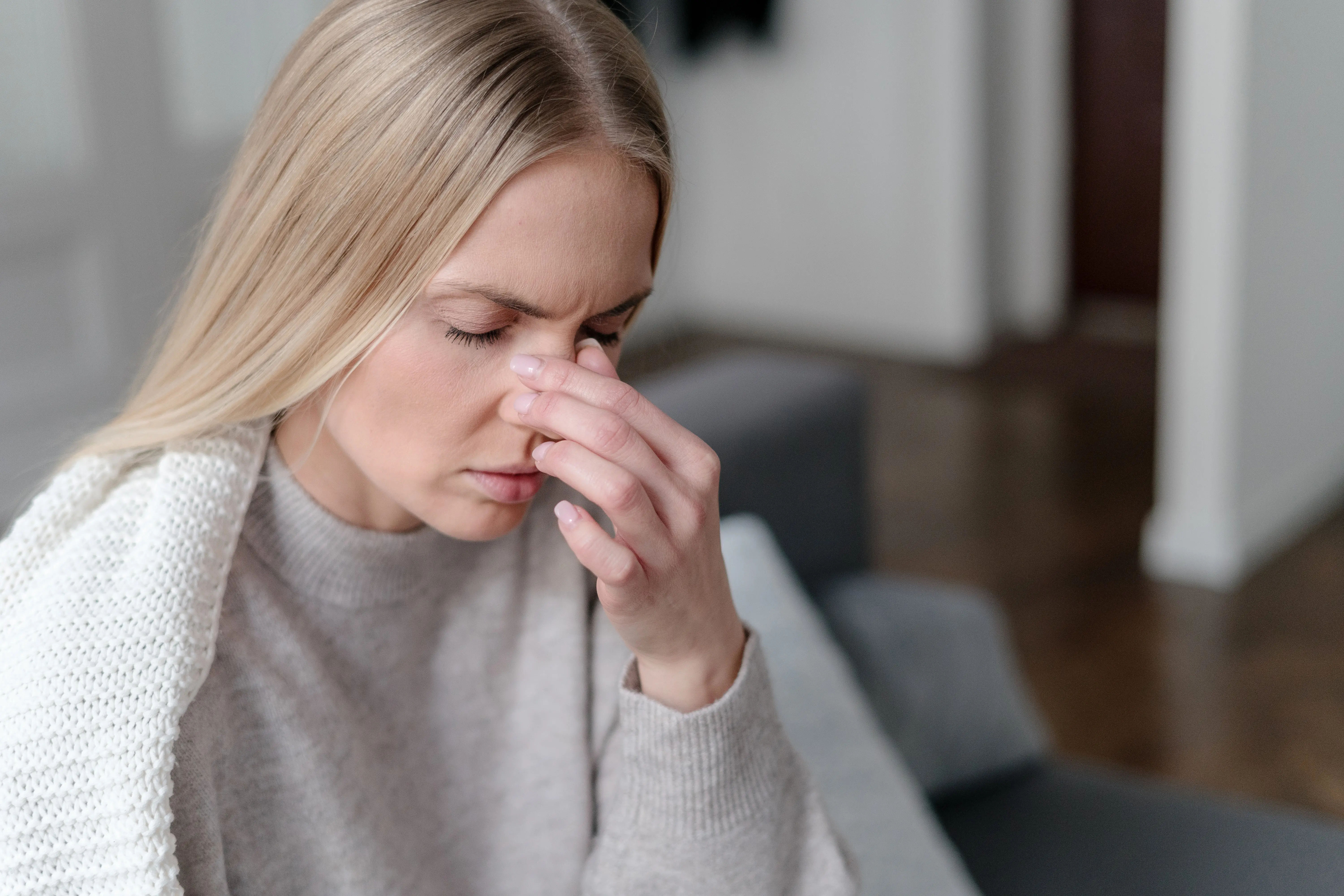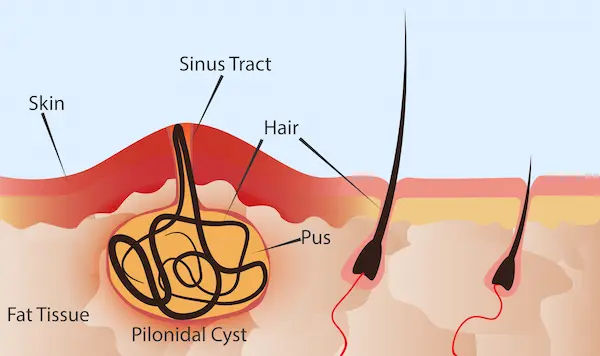Sinus Infection Causes: What’s Really Behind the Pressure?
Know about sinus infections, what it is, their structure, causes, types of infection, risk factors, preventive measures and acute versus chronic sinusitis


Introduction
That familiar, uncomfortable pressure in your cheeks, a headache that worsens when you bend over, and a stubbornly stuffy nose, are the classic signs of a sinus infection, or sinusitis. While often dismissed as "just a bad cold," a sinus infection is a distinct condition with specific triggers. But what exactly flips the switch, turning your healthy sinuses into a breeding ground for discomfort? This article delves deep into the root causes of sinus infections, moving beyond the simple "germs" explanation. We'll explore the intricate anatomy of your sinuses, the various pathogens that can invade them, and the underlying health and environmental factors that make you more susceptible.
Understanding Your Sinuses: The Air-Filled Guardians
Before we can understand what goes wrong, we need to appreciate how your sinuses function when they're healthy. Your sinuses are a system of hollow, air-filled cavities located within the bones surrounding your nose.
Consult an ENT Specialist for Personalised Advice
The Four Pairs of Sinuses and Their Functions
You have four main pairs of sinuses:
1. Maxillary Sinuses: The largest, located in your cheekbones.
2. Frontal Sinuses: Situated in your forehead, above your eyes.
3. Ethmoid Sinuses: Found between your eyes and the bridge of your nose.
4. Sphenoid Sinuses: The deepest set, located behind your ethmoid sinuses and your eyes.
These chambers aren't just space. They lighten the weight of your skull, help humidify and warm the air you breathe, and act as resonating chambers for your voice. Most importantly, they are lined with a soft, pink tissue called the mucous membrane.
The Mucous Membrane: Your First Line of Defense
This membrane is the key player. It produces a thin layer of mucus that traps dust, allergens, pollutants, and microorganisms. Tiny, hair-like structures called cilia then sweep this mucus gently toward the back of the throat, where it's swallowed unconsciously. This process continuously cleanses your sinuses, keeping them healthy and free of infection. A sinus infection occurs when this delicate drainage system is disrupted.
The Main Culprit: How a Sinus Infection Starts
At its core, a sinus infection is an inflammation or swelling of the sinus lining. This inflammation is the common pathway for all causes.
The Domino Effect: From Swelling to Infection
The process typically follows a domino effect:
1. Trigger: Something (like a virus or allergen) irritates the sinus lining.
2. Inflammation: The lining swells up as part of the immune response.
3. Blockage: The swelling narrows or blocks the tiny openings (ostia) that allow the sinuses to drain into the nasal passage.
4. Fluid Buildup: Mucus, which is still being produced, gets trapped inside the sinuses.
5. Infection: The stagnant, moist environment becomes a perfect breeding ground for bacteria, viruses, or fungi to multiply, leading to a full-blown infection and the symptoms of pressure and pain.
Viral Invaders: The Most Common Trigger
The vast majority of acute sinus infections (over 90%) start with a virus, most often the common cold or influenza. The virus causes inflammation in the nasal passages (rhinitis), which spreads to the sinus linings (becoming rhinosinusitis). In most cases, the immune system clears the virus within a week to 10 days. The persistent sinus pressure and nasal congestion you feel is primarily due to this inflammatory response.
Bacterial Intruders: When a Cold Gets Worse
A bacterial sinus infection is often a secondary complication. It occurs when a viral cold blocks the sinuses, creating an environment where bacteria, which may already be present in harmless numbers, can flourish. Signs that a sinus infection may be bacterial include symptoms that last more than 10 days without improvement, or a "double worsening"—you start to feel better from a cold, then suddenly develop a high fever and severe facial pain. Common bacteria involved are Streptococcus pneumoniae and Haemophilus influenzae.
Fungal Sinusitis: A Less Common but Serious Cause
Fungal sinus infections are rare and typically affect people with compromised immune systems or those with significant sinus abnormalities. They can be more serious. There are two main types:
Fungal Ball (Mycetoma): A clump of fungus that grows in a sinus cavity, often causing persistent congestion and facial pain on one side.
Allergic Fungal Sinusitis: An allergic reaction to environmental fungi that leads to significant inflammation and thick, dense mucus.
Beyond Germs: Key Risk Factors and Underlying Conditions
While germs are the direct cause, certain conditions create a "perfect storm" that makes your sinuses more vulnerable.
Anatomical Issues: A Deviated Septum and Nasal Polyps
Physical blockages can prevent proper drainage from the start.
Deviated Septum: The wall (septum) between your nostrils is crooked, which can block sinus passages on one side.
Nasal Polyps: These are soft, noncancerous growths that can dangle from the sinus or nasal lining like small grapes, obstructing drainage and airflow.
The Allergy and Sinus Infection Connection
Allergies are a major driver of chronic sinusitis. Inhaling allergens like pollen, dust mites, or pet dander causes a prolonged inflammatory response in the nasal and sinus passages. This chronic swelling mimics the initial stage of the "domino effect," making it easier for infections to take hold and harder for them to clear. This is a key reason why managing allergies is crucial to preventing recurrent sinus infections.
Weakened Immunity and Chronic Health Conditions
A robust immune system is your best defense. Conditions that weaken it can increase your risk. These include HIV/AIDS, cystic fibrosis (which causes thick mucus), gastroesophageal reflux disease (GERD), and treatments like chemotherapy. Even the normal immune suppression that can occur with high stress or poor sleep can make you more susceptible.
Environmental Irritants and Lifestyle Factors
Every day exposures can irritate your sinus linings:
Smoking and Secondhand Smoke: Chemicals in smoke paralyse the cilia, stopping the mucus-clearing mechanism.
Air Pollution: Similar to smoke, pollutants can cause chronic inflammation.
Chlorine: Frequent swimming in chlorinated pools can irritate the sinus lining.
Air Travel and Diving: Sudden changes in air pressure can block sinus openings.
Acute vs. Chronic Sinusitis: Different Paths, Different Causes
Understanding the duration of your symptoms helps pinpoint the cause.
Defining Acute Sinusitis (Under 4 Weeks)
This is the most common type, usually triggered by a seasonal cold or a bout of allergies. It typically resolves with or without treatment within a month. The primary cause is viral, with bacterial superinfection being a possible complication.
The Persistent Problem of Chronic Sinusitis (12+ Weeks)
When symptoms last for 12 weeks or more despite treatment, it's classified as chronic sinusitis. The causes are often multifactorial and less about a single germ and more about persistent inflammation. The main contributors are:
Poorly controlled allergies.
Structural issues like nasal polyps or a severe deviated septum.
An abnormal immune system response to fungi or bacteria.
Persistent exposure to environmental irritants.
Diagnosing the root cause of chronic sinus infections often requires a visit to an ENT specialist (otolaryngologist) who can perform a nasal endoscopy to look inside your sinuses.
Proactive Steps: How to Reduce Your Risk of Sinus Infections
Prevention focuses on keeping your sinus drainage system healthy.
Practice Good Hand Hygiene: Reduces exposure to cold and flu viruses.
Manage Your Allergies: Work with a doctor to identify triggers and use appropriate medications. If over-the-counter options aren't enough, an allergist can help. Apollo24|7 offers convenient home collection for tests like specific IgE allergy panels.
Use a Humidifier: Adding moisture to dry indoor air prevents sinus linings from drying out and becoming irritated.
Stay Hydrated: Drinking plenty of water keeps mucus thin and easy to drain.
Nasal Irrigation: Using a neti pot or saline spray daily can flush out irritants, allergens, and thick mucus.
Avoid Irritants: Quit smoking and avoid secondhand smoke and polluted air when possible.
When to See a Doctor: Recognising the Red Flags?
While many sinus infections resolve on their own, seek medical attention if you experience:
Symptoms that last more than 10 days without improvement.
A high fever (over 102°F or 39°C).
Severe headache or facial pain that doesn't improve with OTC pain relievers.
Symptoms that worsen after an initial period of improvement ("double worsening").
Visual changes, such as double vision or reduced vision.
Swelling or redness around your eyes.
If your condition does not improve after trying these methods, book a physical visit to a doctor with Apollo24|7.
Conclusion
A sinus infection is more than just a prolonged cold; it's a clear sign that the delicate drainage system of your sinuses has been compromised. The journey from a healthy sinus to an infected one often starts with a simple trigger, a virus, an allergen, or an irritant, that leads to inflammation and blockage. By understanding the chain of events and the underlying risk factors, you can take empowered steps toward prevention and seek timely treatment. Listening to your body and recognising when home care isn't enough is crucial. If you suffer from frequent or severe sinus infections, consider it a signal to investigate deeper with a healthcare professional to address the root cause and finally find lasting relief.
Consult an ENT Specialist for Personalised Advice
Consult an ENT Specialist for Personalised Advice

Dr. Nishant Rana
Ent Specialist
8 Years • MBBS. MS ENT
Delhi
Apollo Hospitals Indraprastha, Delhi

Dr. Tanvi Choubey
Ent Specialist
7 Years • MBBS, MS (ENT). Fellowship in Head Neck Onco Surgery . Consultant - ENT
Rourkela
Apollo Hospitals, Rourkela, Rourkela

Dr. Praveen Sirdesai
Ent Specialist
20 Years • MS
Secunderabad
Apollo Hospitals Secunderabad, Secunderabad

Dr. Riya Das
Ent Specialist
8 Years • MBBS, MS ENT(oto rhino laryngology)
East Midnapore
VIVEKANANDA SEBA SADAN, East Midnapore

Dr. Safina Kauser
Ent Specialist
7 Years • MBBS, MS
Bengaluru
Apollo Clinic, JP nagar, Bengaluru
More articles from sinus disease
Frequently Asked Questions
1. How can I tell if my sinus infection is viral or bacterial?
It can be difficult, but a key indicator is timing. Viral sinusitis usually starts to improve within 5-7 days. A bacterial infection is more likely if symptoms persist for more than 10 days without any improvement, or if you initially feel better from a cold and then suddenly get much worse with a high fever and severe pain.
2. Can a sinus infection go away on its own?
Yes, many acute viral sinus infections will resolve on their own as your immune system fights off the virus. Supportive care, like rest, hydration, steam inhalation, and saline rinses, can help manage symptoms during this time.
3. What is the best way to drain my sinuses naturally?
Nasal irrigation with a saline solution using a neti pot or squeeze bottle is highly effective. Steam inhalation (from a hot shower or a bowl of hot water) can also help loosen thick mucus and promote drainage.
4. Are sinus infections contagious?
The sinus infection itself is not contagious. However, if it was caused by a virus (like a cold), that initial virus is contagious and can be spread to others, who may or may not go on to develop a sinus infection themselves.
5. Why do I keep getting sinus infections?
Recurrent sinus infections often point to an underlying, persistent issue. Common reasons include uncontrolled allergies, anatomical problems like a deviated septum or nasal polyps, exposure to environmental irritants like smoke, or a weakened immune system. An ENT specialist can help diagnose the root cause.

